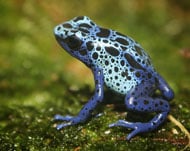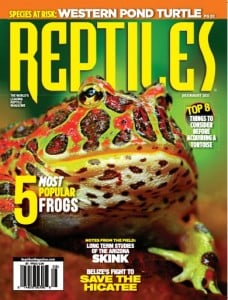Poison Frog
Blue poison frogs are naturally found in the Sipaliwini District of Surinam.
Blue poison frogs are predominantly blue in coloration with small black spots on their dorsum. Their “hunch-back” appearance is another of their recognizable characteristics. As a group, these frogs are known for their toxic skin secretions. This is not a problem with captive raised specimens or animals that have spent considerable time in captivity, as the toxins of wild animals are produced not by the frog, but by the ants that comprise their natural diet. Blue poison frogs lay their eggs on land, usually in a mossy area. Typically, these frogs live four to six years in the wild, but can live much longer in captivity provided with the proper conditions.
Blue poison frogs can be easily kept in captivity, when provided with a few basic requirements. A variety of substrates will suit the needs of these frogs, including everything from simple paper toweling to more natural substrates, such as peat or green moss, coco coir, or a mixture of coco coir and orchid bark. It is important to have a drainage layer at the bottom of the enclosure, which can be made using either pea gravel or LECA (expanded clay pellets), and then covering this with fiberglass window screening to prevent the finer substrate from filling the gaps in the drainage layer. Suitable plants include philodendron, pothos, bromeliads, and other low-growing plants. The substrate should be covered to give the frogs ample hiding places within the environment. This can be accomplished using large magnolia or oak leaves, or by growing pillow moss on the surface of the substrate. Dechlorinated tap water or spring water should be used to mist the enclosure. It is important to have a shallow water dish or area, but keep in mid that these frogs are poor swimmers and the water level should not be higher than three-quarters of the standing height of the frogs. Also, females are very aggressive, so it is generally recommended that no more than a pair be maintained in a given enclosure. A standard 20 gallon aquarium will suit the needs of an adult pair of blue poison frogs. Temperatures in the mid-70s degrees Fahrenheit work well with this species.
Because of their small size, smaller prey items are necessary. Fruit flies, pinhead crickets, termites, aphids and other small non-toxic food items make up an adequate captive diet for this species. Food items should be dusted with a vitamin/mineral supplement once weekly for adult frogs and at every other feeding for young, growing frogs. These active diurnal frogs should be fed three to four times weekly for adults and daily for growing frogs.
For more information, read our detailed poison dart frog care sheet.

